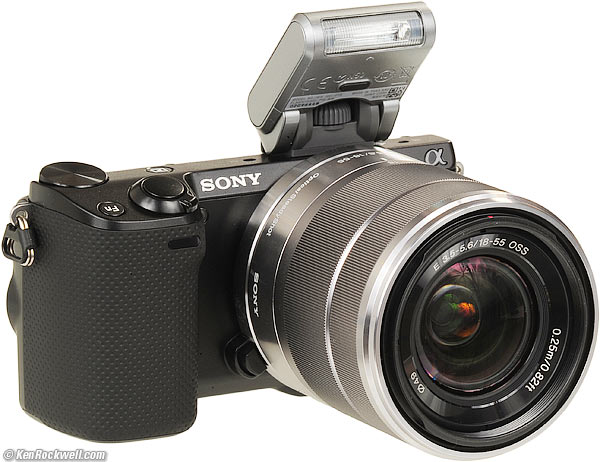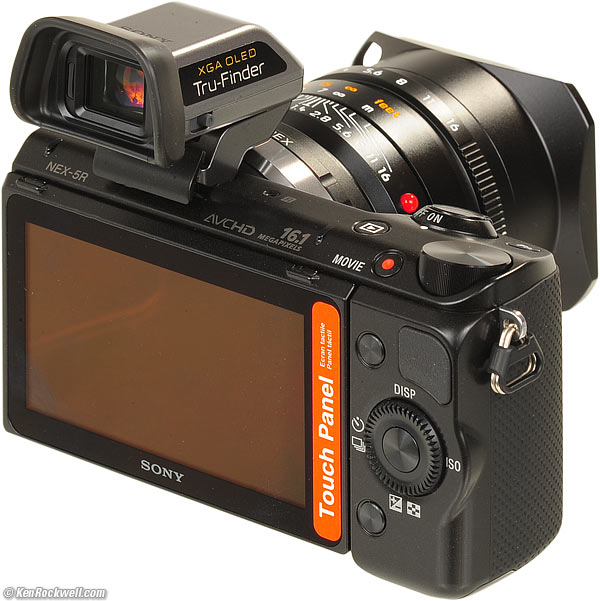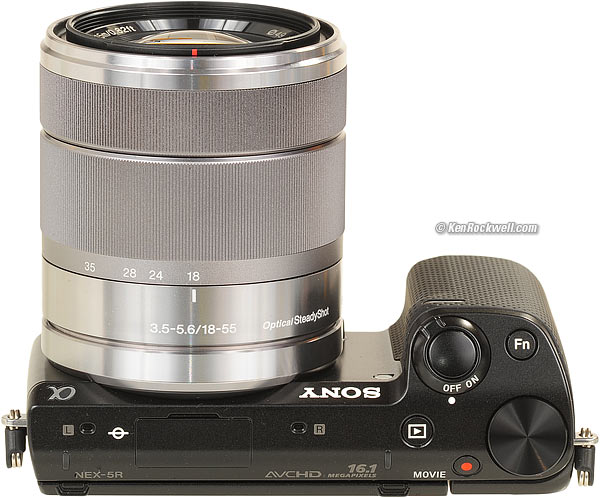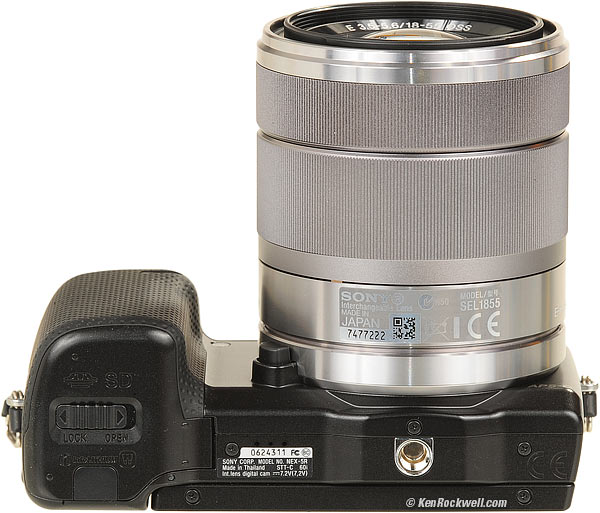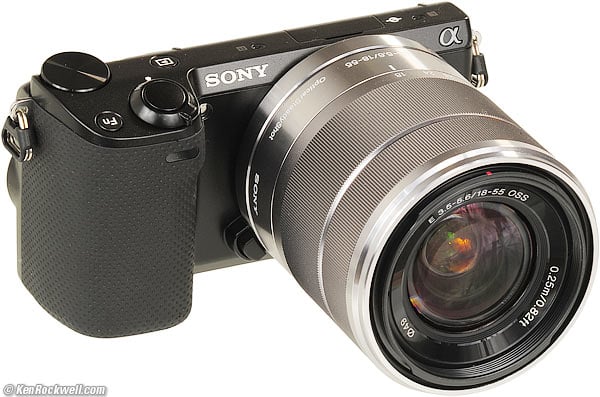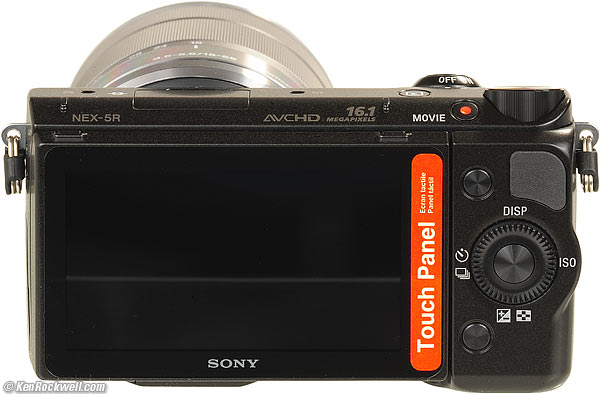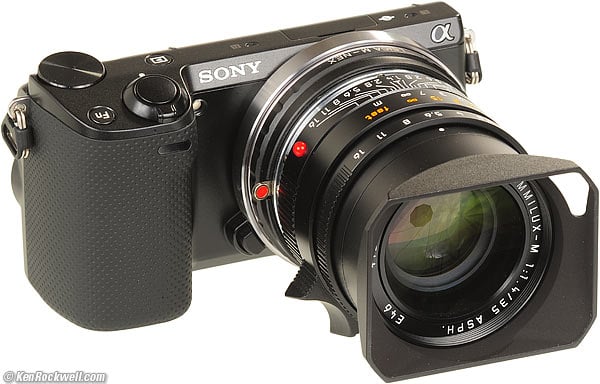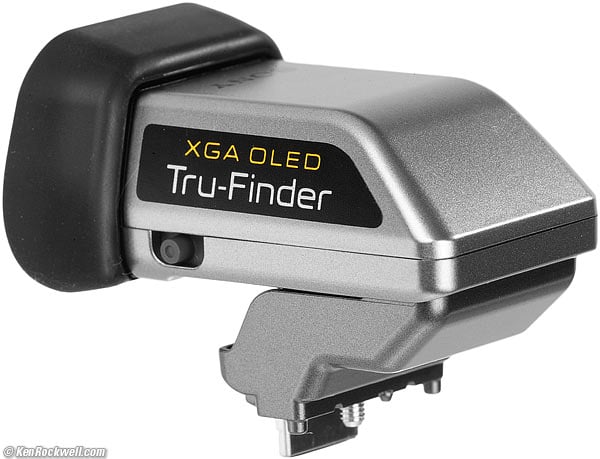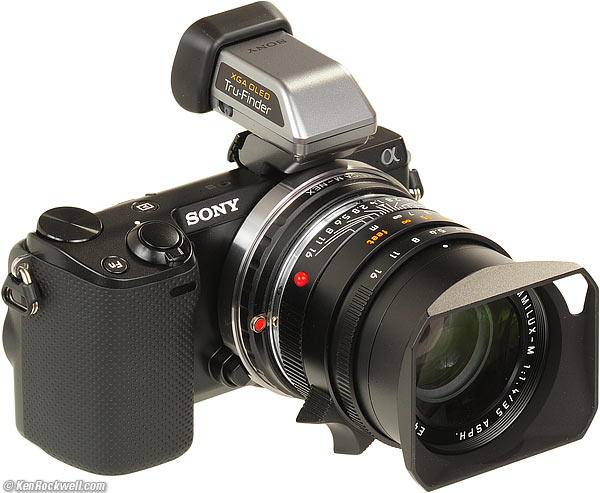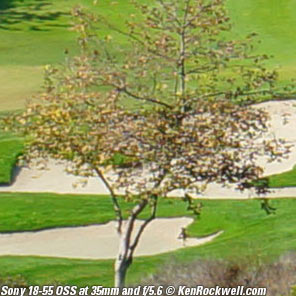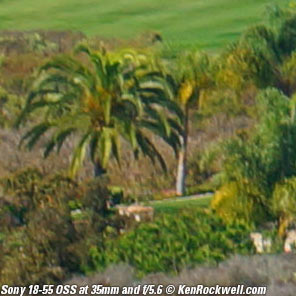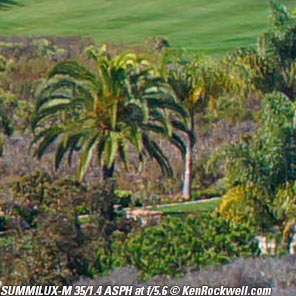Home Donate New Search Gallery Reviews How-To Books Links Workshops About Contact
Sony NEX-5R
16x24mm Mirrorless (2012-)
© 2012 KenRockwell.com. All rights reserved.
Intro Specs Performance Usage Recommendations
Sony: A9 III A1 A9 II A9 A7R V A7R IV A7R III A7 IV A7 III A7R II A7S III A7c A7 II A6600 A6400 A6100 A6000 ZV-E10 RX10/4 RX100/7 RX100/6 Flash Lenses
Sony NEX-5R (9.7 oz./275g with card and battery) with included screw-on HVL-F7S flash and 18-55mm OSS lens (17.2 oz./487g system total, 16 x 24mm sensor, 2.6" equiv. flipping touch screen, finder not included, about $750 with lens or $650 body-only). enlarge. My biggest source of support is when you use any of these links, especially this link directly to it with lens at Adorama (also body-only at Adorama) or directly to it with lens at Amazon (also body-only at Amazon), also in other colors and kits at Adorama and at Amazon, when you get anything, regardless of the country in which you live. Thank you! Ken.
Sony NEX-5R with FDA-EV1S Electronic Finder ($260) and LEICA SUMMILUX-M 35mm f/1.4 ASPH mit floating element ($5,000) and adaptor ($5~$40). enlarge.
November 2012 Sony Reviews Nikon Canon Fuji LEICA All Reviews
FDA-EV1S Electronic Viewfinder Review
Introduction top
Intro Specs Performance Usage Recommendations
The Sony NEX-5R is a tiny camera. It's just a sensor with a grip and lens mount with a flipping LCD on the back. Once you add a lens and flash or finder, it gets much bigger as shown; the camera itself is a slim little thing.
The camera body and tiny included flash attachment weigh nearly nothing; much of the weight will be dependant on which lens you choose to use with it.
To my pleasant surprise, the NEX-5R focuses and shoots nearly instantly. Autofocus is as fast as a DSLR for still shots, and much faster than DSLRs for shooting video, and there is no shutter lag if you know how to use it properly. Therefore, although there often is a slight delay while the photo records before you can make the next shot, for actual shooting, the NEX-5R is just as fast as a DSLR, and can track moving kids just fine. Bravo!
However, the NEX-5R has a huge shortcoming for serious photography: there is only one accessory port on top, so you cannot use the optional but nearly mandatory FDA-EV1S Electronic Viewfinder at the same time as you use the included flash.
No Viewfinder
The NEX-5R has no viewfinder; you have to peer at the tiny image on its rear LCD.
If you want a viewfinder, the optional $260 FDA-EV1S Electronic Viewfinder is excellent, however:
No Flash
If you use the viewfinder, you can't use flash because they each use the same unique dedicated socket!
You can use one or the other, but never both at the same time as we need for almost all serious people and event photography.
You've got to be kidding; any old Canon AE-1 Program or Kodak Brownie Hawkeye has both a live (not electronic) finder and full-time flash connection, both which you need at the same time for serious photography.
Because of this, without fill-flash for people shots, image quality is often poor for people photos if you're using the viewfinder because faces and shadows go too dark (see examples at fill-flash). Flash isn't for low light, and high ISOs can't fix this either; you need flash fill to shine light into dark areas. There is no post-production substitute for fill-flash.
Top, Sony NEX-5R and 18-55mm OSS lens. enlarge.
Bottom, Sony NEX-5R and 18-55mm OSS lens. enlarge.
Sony NEX-5R and 18-55mm OSS lens without flash. enlarge.
Rear, Sony NEX-5R and 18-55mm OSS lens. enlarge.
Sony NEX-5R and LEICA SUMMILUX-M 35mm f/1.4 ASPH mit floating element with an adaptor. enlarge.
Specifications top
Intro Specs Performance Usage Recommendations
Lens Mount
Sony NEX (E-Mount).
Sensor
16 MP CMOS.
1.5x crop factor (23.5 X 15.6mm).
Anti-static coating and ultrasonic cleaner.
RGB primaries; sRGB and AdobeRGB color spaces.
Image sizes
L: 4,912 x 3,264 pixels (16MP).
M: 3,568 x 2,368 (8.4MP).
S: 2,448 x 1,624 (4MP).
Also provides 16:9 crops from the above:
L: 4,912 x 2,760 (14MP).
M: 3,568 x 2,000 (7.1MP).
S: 2,448 x 1,376 (3.4MP) .
Also can stitch panoramas:
Horizontal
12,416 x 1,856 (23MP).
8,192 x 1,856 (15MP).
Vertical
5,536 x 2,160 (12MP).
3,872 x 2,160 (8.4MP).
ISO
Still Photos
Auto ISO 100 ~ 3,200.
Manual ISO 100 ~ 25,600.
Video
Auto ISO 100 ~ 3,200.
Manual ISO 100 ~ 6,400.
White Balance
Auto WB, Daylight, Shade, Cloudy, Incandescent, Fluorescent, Flash, 2,500 ~ 9,900K, all with ±7 units tweak in green/magenta and amber/blue axes. Also Custom (gray-card) WB.
Autofocus
Sony claims "Hybrid" (phase-detection and contrast detection) directly from their fancy CMOS image sensor.
There are 99 points for phase detection and 25 points for contrast detection AF.
AF-S (single) and AF-C (continuous) modes.
Predictive control, Focus lock.
Eye-Start AF only with FDA-EV1S and LA-EA2.
LV +1 to +21 range with f/4 lens.
Face detection.
LED AF assist illuminator with about 10' (3m) range.
Manual Focus
4.8x and 9.6x magnification.
Focus Peaking (white blips magically appear where it's sharp).
Finder
None, rear LCD only — unless you buy the excellent $260 FDA-EV1S finder that replaces the flash.
Live View
That's the only way this camera works — there is no optical finder.
Light Meter
1,200 zone (40 x 30) evaluative.
Flash
No hot shoe — just a weird Sony-dedicated connector.
Screw-on HVL-F7S flash included.
Guide number 7 meters, 23 feet at ISO 100.
Powered from camera.
4 second recycle.
Covers to 16mm lens (24mm equiv.).
Modes: Autoflash, Fill-flash, Rear sync., Slow sync., Rear Sync., Flash Off.
Shutter
Vertical focal-plane.
1/4,000 to 30 seconds, still shots.
Video: 1/4,000 to 1/4 second.
Maximum Shutter Speed with Flash (sync speed): 1/160.
Advance Modes
Single-shot, Continuous, Speed Priority continuous shooting, Self-timer (2s or 10s; 1, 3 or 5 frames), Bracketing, Remote Commander.
Fluff
Scene modes: Portrait, Landscape, Macro, Sports Action, Sunset, Night Portrait, Night View, Handheld Twilight, Anti Motion Blur.
iAUTO
Superior Auto,
Programmed AE (P)
Aperture priority (A)
Shutterspeed priority (S)
Manual (M)
Sweep Panorama
Scene Selection
WiFi and apps for you Internet junkies.
Photo File Formats
JPG.
RAW.
RAW + JPG.
Video
AVCHD Ver. 2.0 (Progressive), AVCHD or MP4.
Image Sizes
480 or 1,080 pixels vertical.
Aspect Ratios
4:3 or 16:9.
Frame Rates
60i and 24p.
Data Rates
17, 24 or 28 MB/s.
3 MB/s at 640 x 480.
Audio
Recorded only along with video.
Stereo microphone.
Mono speaker.
Recording format: Dolby Digital (AC-3) or MPEG-4 AAC-LC (2 channels).
LCD
Touch screen.
16:9 short screen, 3" diagonal with only 2.6" diagonal effective image area. The right side of the screen is usually black when showing images.
921,600 dots.
No automatic brightness control.
Flips +180º and -50º vertically for over and under shots, but doesn't flip for overhead or underhanded vertical shots.
Data Storage
SD, SDHC or SDXC.
Memory Stick PRO or PRO-HG Duo.
Video and Data Communication
Micro USB connector.
Type C mini HDMI.
BRAVIA Sync.
Photo TV HD.
Power
InfoLITHIUM NPFW50 battery (7.2V, 1080 mAh).
2.7 watts rated consumption with E PZ16-50mm F3.5-5.6 OSS lens.
330 shots, rated.
It charges in the camera body via USB.
Sony includes no separate charger, instead, a AC-UB10 AC Adapter is included which is just a 100~240V 50/60 cps. universal AC to 5V USB power adapter.
Quality
Camera and flash made in Thailand.
18-55mm OSS lens made in Japan.
Battery made in Japan.
Size
4.36 x 2.3 x 1.53 inches.
110.8 x 58.8 x 38.9 millimeters.
Weight
NEX-5R body, battery and card: 9.710 oz. (275.2g), measured.
Included screw-on HVL-F7S flash: 0.710 oz. (20.1g).
18-55mm OSS lens: 6.767 oz. (191.8 g).
Total for body, flash and lens: 17.190 oz. (487.3g).
Optional FDA-EV1S finder: 0.955 oz. (27.0 g), replaces the flash.
Sony rates the body as 9.7 oz. (276g) with battery and card, or 7.7 oz. (218g) stripped naked.
Included
NEX-5R body.
Body cap, or 18-55mm OSS lens if you get the kit.
HVL-F7S flash and snap-on plastic case.
NP-FW50 battery; charges in-camera via USB.
AC-UB10 AC Adapter (just an AC to USB power adapter).
Strap.
Micro USB cable for charging and data transfer.
CD-ROM.
1-year warranty.
Two owners manuals, one in English et un en Français.
Optional Accessories
FDA-EV1S Electronic Viewfinder, $260.
Announced
August 2012.
Shipping Since
October 2012.
Price, USA
October 2012: $750 with lens or $650 body-only.
Performance top
Intro Specs Performance Usage Recommendations
I tested the NEX-5R with its 18-55mm OSS kit lens.
The Sony NEX-5R shoots quite quickly once you get it set up; autofocus is almost instantaneous and ambient-light exposure is almost always perfect.
The gotchas are that its limited controls make it clumsy to get it set quickly and these controls also make it tough to see things quickly on playback. It handles faster than a point-and-shoot, but much slower than a DSLR. Once it's set it roars right along, but you'll have to take a little more time-out to change settings than you will with a DSLR.
Not being able to use flash at the same time as the viewfinder is a deal-breaker for most serious photography. I wouldn't buy this camera when a real DSLR like the Nikon D3100 sells for half the price when you include a finder and flash, and isn't much bigger.
Another big problem is that the NEX-5R I bought developed a problem within a few days where the AF-C (continuous AF) often wouldn't focus, but instead sits and oscillates back and fourth between different distances. I reverted to AF-S (single focus and lock) and it was fine. This is too bad because when AF-C works, it works very well for moving targets.
The NEX-5R's rear LCD is tiny. The image doesn't fill the too-short screen; instead the right side of the LCD is black and used only for menu controls:
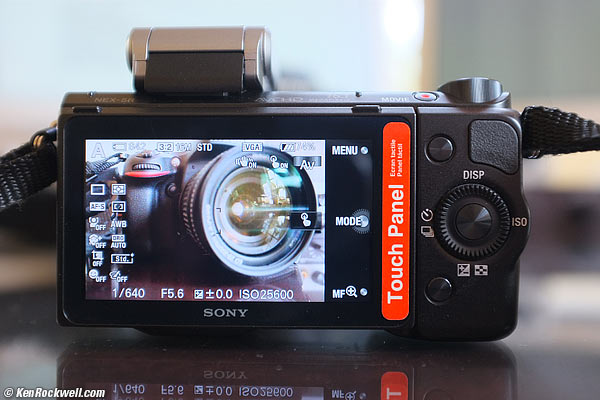
The Sony NEX-5R only uses a 2.6" diagonal section of its 3" LCD for the image. The rest is for menus.
Autofocus
A stand-out feature of the NEX-5R is its super-fast AF. It never gets in the way. It just focuses and lets you get the shot.
Face detection works great; it's magical how well it instantly finds a face and focuses on the eye.
Katie at the Park. (NEX-5R, 18-55 OSS at 50mm, automatic lens corrections all ON, f/5.6 at 1/200 at Auto ISO 100, Auto A4 white balance, greatly warmed in Photoshop CS6 since it was still too darn blue.) bigger.
Face detection is super smart: if there's a face, it finds it, and if not, it focuses on whatever else there is in its normal AF mode.
In AF-C (continuous) mode, focus easily tracks a kid on a swing. It's great — except it stopped working after two days and my NEX-5R would instead keep oscillating back and forth slightly regardless of what was in front of it. It would focus, but it kept breathing in and out.
Optional FDA-EV1S Electronic Viewfinder
Sony FDA-EV1S Finder.
See my separate Sony FDA-EV1S Review.
It's an excellent finder.
Exposure Meter, Ambient Light
The exposure meter works very well. I got correct exposure in almost any sort of light. Remember — if your lighting is poor and there is too much contrast, there is no correct exposure possible unless you pop up the flash to fill-in the shadows.
Flash Exposure
Flash exposure with the included HVL-F7S flash is only fair. It's generally OK if you're not critical, but if you're used to Nikon's or recently Canon's flash exposure control, the NEX-5R isn't always as accurate.
Flash exposure does take distance into account, so it won't get confused shot into a mirror.
HVL-F7S Flash
The tiny little included flash is nice. The nicest thing about it is how you turn it on or off: just flip it up or down! I wish all my flashes were this easy to switch.
Ergonomics
The grip is good. It's easy to grasp.
When holding the camera, the biggest thing is the lens.
Everything for shooting and for playback can be controlled with one hand, which is excellent.
Poor is that the two main menu buttons (the little ones near the top and bottom right of the rear LCD) are impossible to find by feel. They are flat black buttons flush with the flat black rear of the camera, so not only can't they be found by feel as you're looking through the viewfinder, they are also nearly impossible to find by eye while shooting with the rear LCD.
It would be much better if the camera was taller to support a taller LCD. It's too short to be able to display a big enough image.
The touch screen usually only responds to the right part of the screen. If you tap an icon on top of the image while shooting, it ignores you instead of letting you set it. The touch screen for shooting really is only a way to get you work the menu system, not something that just works as you'd like it to.
Once set, most menu items bump you back out of the menu system immediately, so if you need to adjust an adjacent item, you will need to go back in from the top again.
It's too easy to knock the top dial and shift the exposure Program.
The Sony NEX-5R often displays very poorly written error messages, like the meaningless "no images in this view" which means that there's nothing on your card, or other ridiculously obtuse messages for what ought to be simple messages.
If you press PLAY while the NEX-5R is processing the image, you get a gibberish message, and instead of playing as soon as it's done, it just ignores you.
The Fn button is very handy: tap it to get right to color controls, AF mode, AF areas, WB, meter mode and funny picture manipulations.
I never found the exposure compensation adjustment, which is OK because i never needed it. The meter is that good.
Speed
It sometimes take several seconds to wake up from OFF. This is disturbing.
If you know how to use it, there is no shutter lag.
There are tiny delays when changing view formats in playback. This bugs me, but no one else will probably notice it.
Users Manual
The two manuals (one in English, one en Français) are cheaply printed on yellowish newsprint, not clean white paper. They are bound with staples, not perfect-bound like a book.
The manuals are small enough to jam in a camera case (why would anyone use a case with a camera this small?), but unfortunately the text and illustrations have been reduced to fit the smaller printed pages.
Lenses, Corrections and Adapters
I used the included 18-55mm OSS lens, which works fine.
The NEX-5R offers automatic corner darkening, distortion and lateral color fringe correction, and these all work when used with an appropriate lens, like the 18-55.
There are adapters available to use any sort of lens on the NEX. However, you will have to focus manually, you will have to set the aperture manually, and you even will have to open the diaphragm to focus and then close it down to the taking aperture for each shot manually.
Sony NEX-5R with FDA-EV1S Electronic Finder and LEICA SUMMILUX-M 35mm f/1.4 ASPH mit floating element with an adaptor. enlarge.
I compared shots taken at the test range at 16MP with the 18-55mm OSS with shots taken with the LEICA SUMMILUX-M 35mm f/1.4 ASPH mit floating element ($5,000) and adaptor ($5~$40), and they were pretty much the same. I personally wouldn't waste time with manual lenses and adapters. The biggest visible difference is that the images from the kit lens were better because they were warmer, while the LEICA lens was bluer.
Here are crops from 100% 16MP images from each of these lenses:
Center of image from Sony 18-55 OSS |
Center of 35/1.4 ASPH FLE image |
Far right edge, Sony 18-55 OSS |
Far right edge, 35/1.4 ASPH FLE |
If each of these are about 3" (7cm) wide on your screen, the complete printed image would be 50" (1.3 meters) wide.
I don't see enough sharpness difference to make it worth my while to shoot LEICA lenses, and I already have access to the LEICA lenses for free. I prefer the Sony lens for its better color balance on this camera, as well as having autofocus and auto aperture control.
With electronic lens correction, the NEX-5R makes the Sony lens look almost as good as the LEICA lens. The NEX can correct the Sony lens, but not the LEICA lenses. The small sharpness difference isn't worth the inconvenience and inferior color balance.
If you do shoot manual lenses, it's easy to hit a button to zoom-in on the LCD to focus, just that it's difficult to find that button by feel.
You do get auto exposure and and auto ISO with manual adapted lenses.
You'd have to be nuts to use Nikon lenses on this Sony, when you could use those same lenses on a real Nikon body and have all the lens features, like automation and lens correction, work.
If you do get an adapter, be sure not to get one like I did that has a protruding release lever that pokes out pointing towards the grip. When I grab the grip, my finger is drilled by the adapter's release lever!
When you use an adapter, I found no way to program the camera to include the focal length and certainly not the f/stop in the EXIF data.
I also tried the Voigtländer 12mm f/5.6 ASPH, which gives the equivalent of an 18mm lens. It works fine!
Manual Focus
Once you find the magnification button, it's easy.
You can set the LCD for "peaking," which paints obvious false colors on the areas that are in focus, so it's very easy to see what's in focus or not without having to zoom in.
Image Quality
As covered above, if you use a viewfinder and do people photos, image quality is poor since there is no fill-flash.
Color Rendition
Sony's ability to render colors, highlights and shadows is much less mature than higher-tier manufacturers like Nikon and Canon. If you're as critical as I am about color (few people are), Sony's color rendition simply lacks the polish shown by Canon and Nikon's images. Images from this Sony simply lack the better (more exciting and more pleasant) color rendition I get from Canon and Nikon cameras.
Sony lacks the deep resources Canon and Nikon have when it comes to developing the trade-secret algorithms and color matrices required to get great colors as completely and as often as I do with Nikon and Canon.
Great color is not accurate color. That's why Kodak was put out of business by Fuji. Any scientist can get accurate color. Great color is what looks good when photographing real subjects, and I just can't get colors as good from this Sony as I do from my pro cameras. Color rendition is delicate and subjective, and critical when you get serious. You can't just tweak it in a computer; each brand of camera, like each type of film, interprets colors differently.
Lens Corrections
Automatic lens correction works great to eliminate distortion, darkened corners and lateral color fringes.
Funny is that lens correction isn't previewed as you compose, so you'll see distortion as you compose, and once shot, the playback magically shows the correction.
High ISOs
At first I was disappointed with the higher ISO images from the NEX-5R, since I saw noise even on ISO 200 images, and ISO 1,600 images were quite mushy, but when I made some direct comparisons against the Nikon D7000, Fuji X100 and Canon 5D Mark III, I realized that the NEX-5R is about the same as the other half frame sensor cameras. I'm used to shooting full-frame most of the time, and the half-frame (24x16mm) sensor of the NEX-5R just can't compete with full frame sensors.
LCD
The LCD is rated as 3" diagonal, but since it's a very short 16:9 LCD, the image only fills a 2.6" diagonal segment of the larger LCD.
It's not that bright in daylight, and has no auto brightness control.
When composing, there are always various graphics drawn over your image, making it difficult to compose a strong, powerful, simple image. The optional viewfinder is much better at this.
The LCD flips up and down, but not side-to-side, so you can't shoot vertical shots from over your head.
Playback
I never figured out how to swap to other images while zoomed.
It's a tad slow when swapping among the various display options with the DISP button.
If the camera is still processing a just-shot image and you hit PLAY, you'll get an undecipherable warning message that the camera can't do that now, and then it will ignore you instead of just playing the image when it can. You'll have to wait and hit the PLAY button again.
Data
The NEX-5R uses a weird "Micro" USB connector. I had to use the cord that came with my camera instead of any of my usual USB cords.
When formatting cards, Sony only labels the card "NO NAME" instead of properly labeling it "NEX-5R." What idiots; when I get to my studio to download from all my cards, Sony expects me to guess from what camera the NO NAME card came. Sony is clueless here.
There are quite a few crap directories on the card, not just the DCIM folder, so the dingbats at Sony expect me to spend a few more clicks to get to the DCIM folder each time I download. When you do this for a living, every click costs you money.
Shooting ISO, even if set with AUTO ISO, reads perfectly Phase One Media Pro, my preferred sorting software.
Default DPI is 350 DPI. I prefer 72 DPI as it often saves me a click or two when creating web graphics over which I'm dropping text.
The NEX-5R uses five digits in its file numbers, like DSC00369.JPG, so it ought to be able to record 100,000 files until it wraps around to DSC00001.JPG again.
Movies
Movies seem efficient in file size and look fine.
Autofocus works pretty well. Once it grabs focus in AF-C mode, it easily tracks Katie on the swing, which is better than I've ever got from DSLR video.
Stereo sound sounds great, and of course since the camera is often so close to your face you may hear yourself breathing.
There's an easy-to-find red MOVIE button to start and stop movies. Since it's flush with the top of the camera and doesn't click much when pushed, it's a bit of a crap shoot knowing if the movie's started or not. Just as bad, it's common that I'll hit the MOVIE button to stop, and not notice until a while later that the camera ignored my button push and never stopped recording.
With the flippy LCD flipped up, it usually gets in the way of the MOVIE button, making it difficult to press.
Power
The battery goes in most of the way regardless of orientation. This is bad; it shouldn't go in at all unless you have it the right way. This makes one sometimes have to try a few times until it goes all the way in the right way.
There is no separate charger; just like a phone, the charge circuitry is in the camera. The included "charger" is just a wall power to USB adapter; you can charge it off any other iPod or other USB charger or socket as well.
There is a tiny hidden yellow LED near the USB connector that lights when charging. It's hard to see inside the flap unless you look for it.
Battery life is poor. Since the camera and LCD and sensor and computers are always on anytime I'm using the camera, I only get about 330 shots as rated on a charge. A DSLR gets three times more shots — or more — on a charge because a DSLR's circuitry is off all the time I'm sighting through the camera.
Luckily the percentage of charge is always shown, not just a bar graph, since you always need to watch the battery.
Unlike DSLRs, you'll always be charging this battery every time you shoot. I doubt you'd be able to go away for a weekend and not bother to bring a charger.
Fluff
As a photographic artist, as opposed to a computer hobbyist, I have no time for fluff like HDR and all the other non-photo baloney with which these Oriental cameras are loaded today. When you know photography, you're too busy worrying about what's in your shot and how you've designed the composition to have time to waste thinking about your camera or anything else not directly related to the content of your image.
The one corny feature that's automatically enabled by default is the "Automatic Portrait Framing" option. What it does is save the shot you made, and also save a second shot, with its own new sequential file number.
The camera thinks it's smarter than you, so this feature saves a second more tightly cropped version of many people photos. It will save a cropped version that may be at a different orientation (vertical or horizontal) than your first shot.
Usage top
Intro Specs Performance Usage Recommendations
I prefer to turn off image review, since if it's on, the camera hangs up for those two seconds after each shot before it can shoot the next shot.
If you plug into a PC, turn the power switch OFF to charge, or ON to download. It can't do both at the same time.
Recommendations top
Intro Specs Performance Usage Recommendations
The NEX-5R is best shot without asking questions. It gets clumsy for playback or making shooting adjustments, so it's best just to shoot and do your best to avoid playing in the menus.
Personally, the NEX-5R is too expensive and not competitive with real DSLRs like the Nikon D3100 and D3200, each of which has superior performance at half the price. Remember, by the time you buy the viewfinder, the NEX-5R and lens costs $1,010. Even if the price was the same, the small difference in size and weight just isn't worth the performance tradeoffs in image quality and ergonomics for me. Of course others love these little things for their smaller size and don't care about the cost or fill flash or color rendition as I do. This is why there's a zillion kinds of cameras out there.
Personally I prefer my Fuji X100 when it comes to mirrorless cameras. The X100 has the same size sensor, a bigger effective-sized LCD, and it's smaller, lighter and performs better with built-in flash and two different viewfinders!
For me, the inability to use a viewfinder and the flash at the same time with the NEX-5R is a complete deal-breaker. Likewise, the relatively immature color rendition makes this Sony something I'll review, but not use for my own shooting.
Many people love playing with different lenses and adapters, but that's playing, not photography. With the electronic lens corrections in the NEX-5R, the dinky kit lens performs as well as a $5,000 LEICA SUMMILUX-M 35mm f/1.4 ASPH mit floating element.
If you've found all the time, effort and expense I put into researching and sharing all this, my biggest source of support is when you use any of these links, especially this link directly to it with lens at Adorama (also body-only at Adorama) or directly to it with lens at Amazon (also body-only at Amazon), also in other colors and kits at Adorama and at Amazon, when you get anything, regardless of the country in which you live.
Thank you!
Ken.
Help me help you top
I support my growing family through this website, as crazy as it might seem.
The biggest help is when you use any of these links when you get anything, regardless of the country in which you live. It costs you nothing, and is this site's, and thus my family's, biggest source of support. These places have the best prices and service, which is why I've used them since before this website existed. I recommend them all personally.
If you find this page as helpful as a book you might have had to buy or a workshop you may have had to take, feel free to help me continue helping everyone.
If you've gotten your gear through one of my links or helped otherwise, you're family. It's great people like you who allow me to keep adding to this site full-time. Thanks!
If you haven't helped yet, please do, and consider helping me with a gift of $5.00.
As this page is copyrighted and formally registered, it is unlawful to make copies, especially in the form of printouts for personal use. If you wish to make a printout for personal use, you are granted one-time permission only if you PayPal me $5.00 per printout or part thereof. Thank you!
Thanks for reading!
Mr. & Mrs. Ken Rockwell, Ryan and Katie.
Home Donate New Search Gallery Reviews How-To Books Links Workshops About Contact

